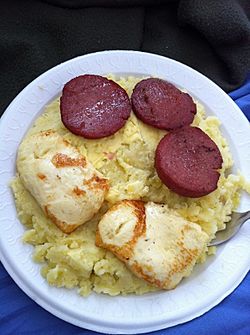Mangú facts for kids
 |
|
| Alternative names | Mazamorra (squash version) |
|---|---|
| Course | Breakfast, main course or side dish |
| Place of origin | Dominican Republic |
| Associated national cuisine | Dominican Republic cuisine |
| Serving temperature | Hot |
| Main ingredients | Green plantains, red onion, vinegar |
| Ingredients generally used | Queso frito, fried eggs, fried Dominican Salami |
| Variations | Mofongo, Fufu, Tacacho, Cayeye |
Mangú is a very popular and traditional dish from the Dominican Republic. Many people in the Dominican Republic enjoy mangú for breakfast. You can also find it served for lunch or dinner. It's a simple yet delicious meal made from green plantains.
Contents
How to Make Mangú
Making mangú is quite easy! First, you boil green plantains. You can boil them with or without their peel. Once the plantains are soft and fully cooked, you remove the peel if it's still on.
Next, you mash the cooked plantains with a fork. You add a little bit of the water they were boiled in. The goal is to mash them until they are smooth, with very few or no lumps. To finish, mangú is usually topped with red onions that have been lightly cooked with vinegar and oil.
Mangú Variations
Los Tres Golpes
A very common way to eat mangú is with "Los tres golpes," which means "the three hits." This is a fun, slang name Dominicans use for a special combination. "Los tres golpes" includes:
- Fried Dominican-style salami
- Fried cheese
- Fried eggs
These tasty additions are served right alongside the mangú. Sometimes, the salami and cheese are coated in flour before frying. This makes them extra crispy!
Other Plantain Dishes
While green plantains are traditional, you can also make mangú using ripe plantains, green bananas, or even squash. When made with squash, the dish is known as mazamorra.
The History of Mangú
Where the Name Comes From
The idea of boiling and mashing root vegetables like plantains came from Africa. People from the Congo region were brought to the island during the slave trade. They brought their cooking traditions with them. The original word for this type of mashed food was something like "mangusi." It was used for almost any root vegetable that was boiled and mashed.
Mangú Around the World
Mangú is part of a larger family of dishes called Fufu. Fufu was brought to the Caribbean and parts of Latin America by African slaves. In the past, before cassava was common, people would boil and mash plantains, green bananas, and yams. They would mix them with milk, butter, and the water they were boiled in.
Today, you can find similar mashed plantain dishes in many countries:
- In the Dominican Republic, it's called mangú.
- In Cuba and Panama, it's known as fufu de plátano.
- In Costa Rica, it's angú.
- In Belize, it's hudut.
- In Ecuador, it's bolón.
- In Peru, it's tacacho.
- In Puerto Rico, it's mofongo.
- In Colombia, it's cayeye or cabeza de gato.
Fun Stories About Mangú
There's a popular story about how the name "mangú" came to be. The tale says that during the American occupation of the Dominican Republic in the early 1900s, American soldiers tried the dish. One soldier supposedly exclaimed, “Man, good!” This sounds like "mangú." However, there's no real proof from that time to show this story is true. It's just a fun folk tale!
Mangú's Role in Dominican Life
Mangú is a very important dish to the people of the Dominican Republic. It's deeply rooted in their culture and has played a big part in feeding the Dominican people, especially during tough economic times. It has always been a reliable and filling meal for many families.
See also
 In Spanish: Mangú para niños
In Spanish: Mangú para niños

